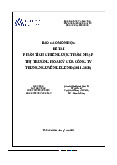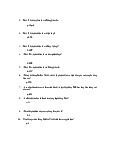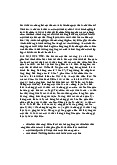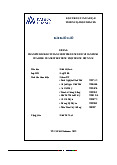



Preview text:
The NAFTA Tomato Wars
When the North America Free Trade Agreement (NAFTA) went into effect in December 1992 and
tar- iffs on imported tomatoes were dropped, U.S. tomato producers in Florida feared that they
would lose busi- ness to lower-cost producers in Mexico. So they lobbied the government to set
a minimum floor price for toma- toes imported from Mexico. The idea was to stop Mexican
producers from cuKng prices below the floor to gain share in the U.S. market. In 1996, the United
States and Mexico agreed on a basic floor price of 21.69 cents a pound.
At the Ome, both sides declared themselves to be happy with the deal. As it turns out, the deal
didn’t offer much protecOon for U.S. tomato growers. In 1992, the year before NAFTA was passed,
Mexican producers ex- ported 800 million pounds of tomatoes to the United States. By 2011, they
were exporOng 2.8 billion pounds of tomatoes, an increase of 3.5-fold. The value of Mexican
tomato exports almost tripled over the same period, to $2 billion. In contrast, tomato producOon
in Florida has fallen by 41 percent since NAFTA went into effect. Flor- ida growers complained that
they could not compete against low wages and lax environmental oversight in Mexico. They also
alleged that Mexican growers were dumping tomatoes in the U.S. market at below the cost of
producOon, with the goal of driving U.S. producers out of business.
In 2012, Florida growers peOOoned the U.S. Depart- ment of Commerce to scrap the 1996
minimum price agreement, which would then free them up to file an anO- dumping case against
Mexican producers. In September 2012, the Commerce Department announced a prelimi- nary
decision to scrap the agreement. At first glance, it looked as if the Florida growers were going to
get their way. It soon became apparent, however, that the situaOon was more complex than
appeared at first glance. More than 370 business and trade groups in the United States— from
small family-run importers to meat and vegetable producers and Wal-Mart Stores—wrote or
signed le\ers to the Commerce Department in favor of conOnuing the 1996 agreement.
Among the le\er writers was Kevin Ahern, the CEO of Ahern Agribusiness in San Diego. His
company sells about $20 million a year in tomato seeds and trans- plants to Mexican farmers. In
a le\er sent to The New York Times, Ahern noted that “yes, Mexico produces their tomatoes on
average at a lower cost than Florida; that’s what we call compeOOve advantage.” Without the
agreement Ahern claimed that his business would suf- fer. Another U.S. company, NatureSweet
Ltd., grows cherry and grape tomatoes under 1,200 acres of green- houses in Mexico for the
American market. It employs 5,000 people, although all but 100 work in Mexico. The CEO, Bryant
Ambelang, said that his company couldn’t survive without NAFTA. In his view, Mexican-grown
tomatoes were more compeOOve because of lower labor costs, good weather, and more than a
decade of invest- ment in greenhouse technology. In a similar vein, Sco\ DeFife, a representaOve
of the U.S. NaOonal Restau- rant AssociaOon, stated, “people want tomato-based dishes all the
Ome. . . . You plan over the course of the year where you are going to get your supply in the win-
ter, spring, fall.” Without tomatoes from Mexico, a win- ter freeze in Florida, for example, would
send prices shooOng up, he said.
Faced with a potenOal backlash from U.S. importers, and from U.S. producers with interests in
Mexico, the Commerce Department pulled back from its iniOal con- clusion that the agreement
should be scrapped. Instead, in early 2013, it reached an agreement with Mexican grow- ers to
raise the minimum floor price from 21.69 cents a pound to 31 cents a pound. The new agreement
also es- tablished even higher prices for specialty tomatoes and tomatoes grown in controlled
environments. This was clearly aimed at Mexican growers, who have invested bil- lions to grow
tomatoes in greenhouses. Florida tomatoes are largely picked green and treated with gas to change their color.
Case%Discussion%Questions%
1. Was&the&establishment&of&a&minimum&floor&price&for&tomatoes&consistent&with&the&free&trade&
principles&enshrined&in&the&NAFTA&agreement?&&
2. Why,&despite&the&establishment&of&a&minimum&floor&price,&have&imports&from&Mexico&grown&
over&the&years?&&
3. Who&benefits&from&the&importation&of&tomatoes&grown&in&Mexico?&Who&suffers?&&
4. Do&you&think&that&Mexican&producers&were&dumping&tomatoes&in&the&United&States?&&
5. Was&the& Commerce&Department& right&to& establish&a& new&minimum& floor&price& rather&than&
scrap& the& agreement& and& file& an& antidumping& suit?& Who& would& have& benefited& from& an&
antidumping&suit&against&Mexican&tomato&producers?&Who&would&have&suffered?&&
6. What&do&you&think&will&be&the&impact&of&the&new&higher&floor&price?&Who&benefits&from&the&
higher&floor&price?&Who&suffers?&&
7. What&do&you&think&is&the&optimal&government&policy&response&here?&Explain&your&answer.&&
Subaru’s Sales Increase because of Yen
For&the& Japanese& carmaker&Subaru,& a&sharp& fall& in&the& value& of&the& yen&against& the&U.S.&dollar& has&
turned&a&problem—the&lack&of&U.S.&production—into&an&unexpected&sales&boom.&Subaru,&which&is&a&
niche& player& in& the& global& auto& industry,& has& long& bucked& the& trend& among& its& Japanese& rivals& of&
establishing&significant&manufacturing&facilities&in&the&North&American&market.&Instead,&the&company&
has&chosen&to&concentrate&most&of&its&manufac-&turing&in&Japan&in&order&to&achieve&economies&of&scale&
at&its&home&plants,&exporting&its&production&to&the&United&States.&Subaru&still&makes&80&percent&of&its&
vehicles&at&home,&compared&with&21&percent&for&Honda.&
Back&in&2012,&this&strategy&was&viewed&as&something&of&a&liability.&In&those&days,&1&U.S.&dollar&bought&
only&80&Japanese¥.&The&strong¥&meant&that&Subaru&cars&were&being&priced&out&of&the&U.S.&market.&
Japanese&com-&panies&like&Honda&and&Toyota,&which&had&substantial&pro-&duction&in&the&United&States,&
gained&business&at&Subaru’s&expense.&But&from&2012&onward,&with&Japan&mired&in&re-& cession&and&
consumer& prices& falling,& the& country’s& central& bank& repeatedly& cut& interest& rates& in& an& attempt& to&
stimu-&late&the&economy.&As&interest&rates&fell&in&Japan,&investors&moved&money&out&of&the&country,&
selling¥& and&buying&the& U.S.&dollar.&They& used&those& dollars&to&invest& in&U.S.&stocks& and&bonds,&
where&they&anticipated&a&greater&return.&As&a&consequence,&the&price&of¥&in&terms&of&dollars&fell.&By&
December&2015,&1&dollar&bought&120¥,&representing&a&50&percent&fall&in&the&value&of&the¥&against&
the&U.S.&dollar&since&2012.&
For&Subaru,&the&depreciation&in&the&value&of&the¥&has&given&it&a&pricing&advantage&and&driven&a&sales&
boom.&Demand&for&Subaru&cars&in&the&United&States&has&been&so&strong&that&the&automaker&has&been&
struggling&to&keep&up.&The&profits&of&Subaru’s&parent&company,&Fuji&Heavy&Industries,&have&surged.&In&
February&2015,&Fuji&an-&nounced&that&it&would&earn&record&operating&profits&of&around&¥410&billion&
($3.5&billion&U.S.)&for&the&financial&year&ending&March&2015.&Subaru’s&profit&margin&has&in-&creased&to&
14.4&percent,& compared&with& 5.6&percent&for& Honda,&a& company&that& is&heavily&dependent& on&U.S.&
production.&The& good×&continued& in&2015,& with&Subaru&posting& record&profits& in&the& quarter&
ending&December&31,&2015.&
Despite&its¤t&pricing&advantage,&Subaru&is&mov-&ing&to&increase&its&U.S.&production.&It&plans&to&
expand&its&sole&plant&in&the&United&States,&in&Indiana,&by&March&2017,&with&a&goal&of&making&310,000&
a&year,&up&from&200,000¤tly.&When&asked&why&it&is&doing&this,&Suba-&ru’s&management¬es&
that&the¥&will¬&stay&weak&against&the&dollar&forever,&and&it&is&wise&to&expand&local&production&as&
a&hedge&against&future&increases&in&the&value&of&the¥.&Indeed,&when&the&Bank&of&Japan&decided&to&
set&a&key&interest&rate&below&zero&in&early&February&2016,&the¥&started&to&appreciate&against&the&
U.S.& dollar,& presumably& on& expectations& that& negative& interest& rates& would& finally& help& stimulate&
Japan’s&sluggish&economy.&By&late&March&2016,&the¥&had&appreciated&against&the&dol-&lar&and&was&
trading&at&$1&=&¥112.& & & Case%Discussion%Questions%
1.&Why&do&you&think&that,&historically,&Subaru&chose&to&export&production&from&Japan&rather&than&set&
up&manufacturing&facilities&in&the&United&States&like&its&Japanese&rivals?&
2.& What& are& the& currency& risks& associated& with& Subaru’s& export& strategy?& What& are& the& potential& benefits?&
3.&Why&did&Subaru’s&sales&and&profits&surge&in&2014&and&2015?&
4.&Is&Subaru&wise&to&expand&its&U.S.&production&capacity?&What&other&strategies&could&the&company&
use&to&hedge&against&adverse&changes&in&exchange&rates?&What&are&the&pros&and&cons&of&the&different&
hedging&strategies&Subaru&might&adopt?&




